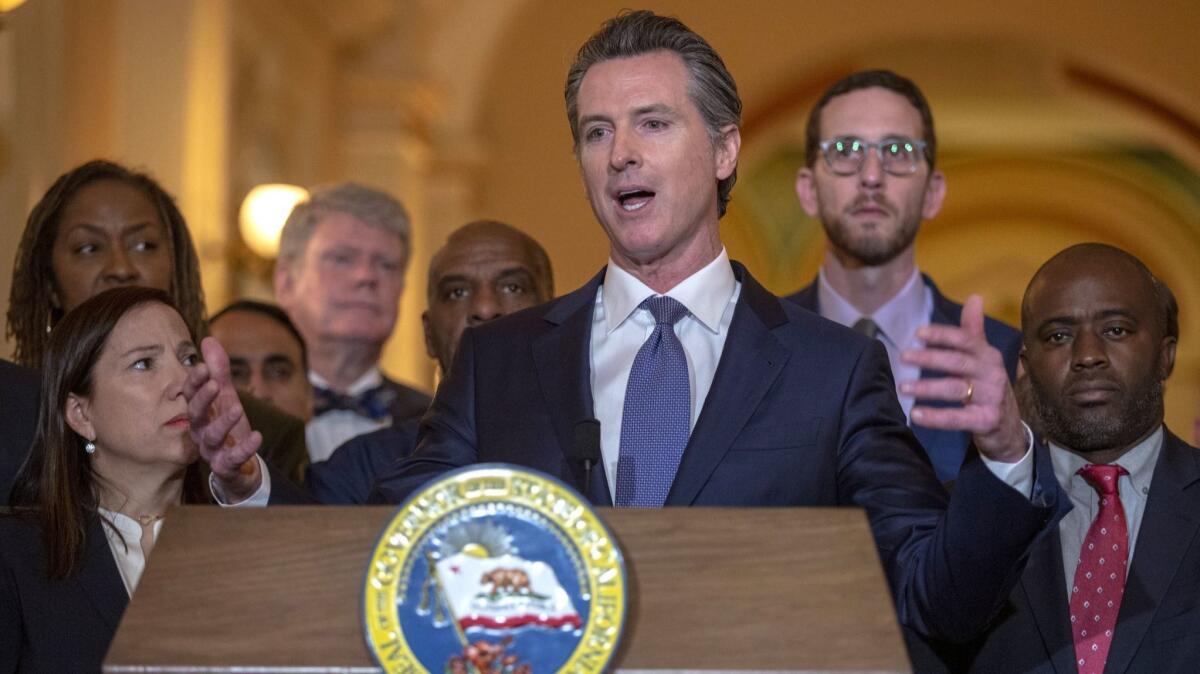Capitol Journal: Newsom should close down California’s death row the right way — at the ballot box

- Share via
Reporting from Sacramento — If Gov. Gavin Newsom wants to abolish capital punishment the right way — at the ballot box rather than by gubernatorial edict — his best opportunity will come next year, a new poll indicates.
A record number of California voters now favor scrubbing the death penalty for first-degree murderers and replacing it with life behind bars without the possibility of parole, the Public Policy Institute of California reports.
Among likely voters the numbers are death 38%, life 58%.
The only way Newsom can permanently eliminate capital punishment in California is by persuading voters to amend the state Constitution.
The controversial death penalty moratorium that Newsom recently declared is enforceable only while he is governor. His successor could restore capital punishment, at least in theory.
The reality is there hasn’t been an execution in California since 2006. Only 13 have occurred since 1978.
Regardless of whether you’re for or against the death penalty, the fact is it simply isn’t working in California. The system is dysfunctional.
Death row is packed with 737 condemned killers. Their chief cause of death is old age or suicide. It’s a huge waste of money — at least $5 billion more over the years than what life sentences would have cost. And the killers are coddled compared with other state prisoners. They get their own cells, free legal service, generous yard time and don’t have to work.
San Quentin’s death row could be closed down for good in next year’s election. The time seems ripe.
California voters have been trending toward opposing capital punishment — at least in polls, although not in elections.
Democrats compose the most ardent group of death penalty opponents — 76% of those interviewed in the PPIC poll. They’re likely to turn out in droves next year trying to oust President Trump. It should be a banner year for all things Democrat in California.
Conversely, the most dedicated bloc of capital punishment supporters is Republicans — 71% of them in the poll. But they’re falling off a cliff in California. Their numbers are down to 23.6% of registered voters. Democrats are holding steady at 43%.
Independents — registered as “no party preference” — have passed the GOP at 28.3%. Among them, 56% favor shuttering death row.
Anti-death-penalty sentiment is especially strong among San Francisco Bay Area residents, voters under 45, college graduates, poor people and naturalized citizens, the poll shows.
Of course, death penalty repeals were on the ballot in 2012 and 2016 and failed both times. In fact, voters in 2016 narrowly passed an initiative to expedite executions.
“The death penalty is a very emotional issue,” PPIC President Mark Baldassare says. “In initiative campaigns, repeal opponents have been able to highlight murder cases that cause people to think twice — terrible cases that are really disturbing.
“In 2012 and 2016, Californians who might otherwise have voted for repeal said, ‘You know, maybe I’m not ready to change the law.’ They question their own judgment as to whether they know enough.
“With initiatives, it’s always easier to vote ‘no.’”
Polls showed voters favoring repeal before those elections, too, but they crossed up the pollsters.
“There’s been a big decline in support for the death penalty,” Baldassare says, “but has sentiment changed enough so that if a repeal went on the ballot in 2020 it would win? It’s hard to say.”
Kent Scheidegger of the Criminal Justice Legal Foundation, which fights for the death penalty, asserts that the usual wording of capital punishment poll questions elicits wrong answers.
The question usually involves a choice of death or life for “all murderers,” he says.
“If I had to choose between executing ‘all murderers’ or none of them, I would say none.
“The actual question to be decided is: ‘What penalty do you want for the very worst murders?’ Nobody is seeking a mandatory death penalty for all first-degree murders. That’s been unconstitutional since 1976.”
He’s correct. Only those found guilty of the very worst killings are sentenced to death — roughly 5% of first-degree murderers in California.
Scheidegger agrees with Baldassare’s analysis of why voters ultimately decide against repeal.
“Most people don’t really grasp how horrible these crimes really are,” he says. “The crimes that land people on death row are not typical murders. You’ve got serial killers. You’ve got people who rape and murder children.”
Assemblyman Marc Levine (D-San Rafael) has introduced a constitutional amendment to substitute life in prison for the death penalty. He wants it on the 2020 general election ballot.
But it will require a two-thirds majority vote in each legislative house — a difficult task. Democrats hold supermajorities, but some moderates in competitive districts are skittish.
“Tough? Absolutely,” Levine says. “But if we get it on the ballot, I’m very confident we will win. Newsom’s leadership is a game changer. And we need the governor to help us make the case just to get it on the ballot. We didn’t have a leader in 2016. Now we do.”
Former Gov. Jerry Brown, a lifelong death penalty opponent, kept mum both in 2012 and 2016.
Newsom’s bold moratorium ignored the voters’ will and violated his preelection promise to carry out the death penalty law. That didn’t seem to hurt or help him politically, the pollster says.
Among voters, 45% approve of his job performance and 36% disapprove.
Newsom should use his ample political capital to close down death row the right way — by asking voters to do it.
Follow @LATimesSkelton on Twitter
More to Read
Get the L.A. Times Politics newsletter
Deeply reported insights into legislation, politics and policy from Sacramento, Washington and beyond. In your inbox twice per week.
You may occasionally receive promotional content from the Los Angeles Times.











